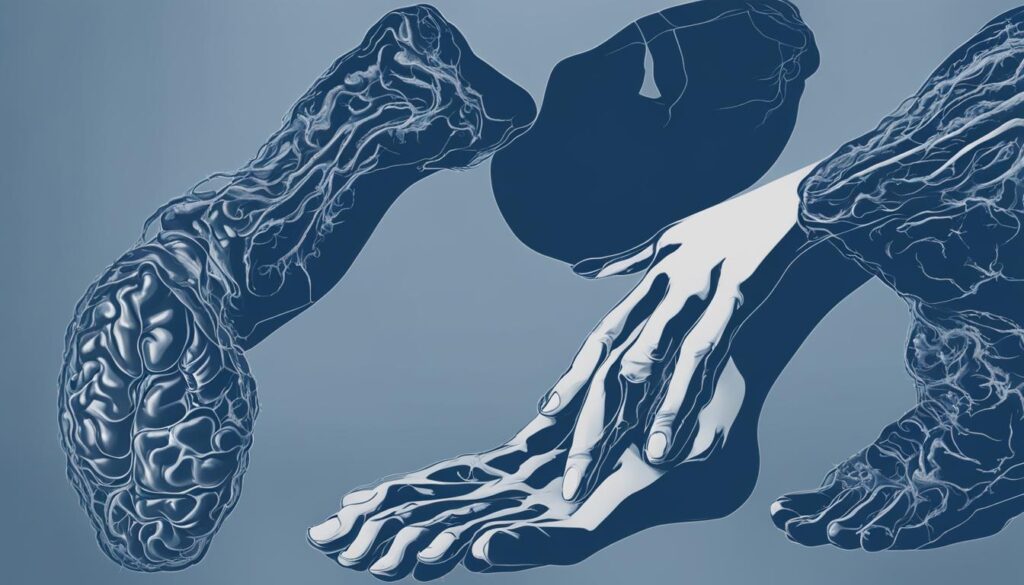Hand and foot cramps can be a frustrating and painful experience. These involuntary muscle contractions and spasms can occur in various parts of the body, including the legs, hands, feet, arms, and abdomen. If you’re wondering what deficiency might be causing your hand and foot cramps, it’s important to consider vitamin and mineral imbalances as potential culprits.
Dehydration, sedentary lifestyle, intense exercise, and electrolyte deficiencies can all contribute to muscle cramps. Identifying and addressing the underlying deficiency is crucial for finding long-term relief and preventing future cramps.
Key Takeaways:
- Hand and foot cramps can be caused by deficiencies in vitamins and minerals.
- Dehydration is a common cause of muscle cramps.
- A sedentary lifestyle can contribute to muscle tension and cramping.
- Intense exercise can trigger hand and foot cramps.
- Electrolyte imbalances, such as deficiencies in magnesium, calcium, sodium, and potassium, can lead to muscle cramps.
Dehydration as a Cause of Hand and Foot Cramps
Dehydration is a common factor contributing to muscle cramps, including hand and foot cramps. When the body loses water through sweating, especially during hot weather or intense exercise, it can lead to a depletion of fluids and electrolytes. This imbalance can disrupt the normal functioning of muscles, causing them to contract involuntarily and result in cramps.
Preventing dehydration is crucial in reducing the risk of muscle cramps. Maintaining adequate fluid intake is essential, especially during physically demanding activities. Drinking water and electrolyte-rich beverages, such as sports drinks or coconut water, can help replenish the lost fluids and minerals, reducing the likelihood of cramps.
In addition to staying hydrated, it’s important to be mindful of other factors that can contribute to dehydration. These include excessive alcohol consumption, certain medications, and medical conditions that increase fluid loss. By addressing these underlying causes and ensuring proper hydration, individuals can significantly reduce the occurrence of hand and foot cramps.
Prevention of Dehydration and Muscle Cramps
To prevent dehydration and minimize the risk of muscle cramps, consider the following tips:
- Drink an adequate amount of water throughout the day, aiming for at least eight glasses or 64 ounces.
- Stay hydrated before, during, and after physical activity, especially in hot and humid environments.
- Include electrolyte-rich foods and beverages in your diet, such as bananas, oranges, spinach, yogurt, and coconut water.
- Avoid excessive consumption of alcohol and caffeinated beverages, as they can contribute to dehydration.
- Be aware of the signs of dehydration, including thirst, dry mouth, dark urine, fatigue, and dizziness, and take immediate steps to rehydrate.
By prioritizing hydration and adopting healthy lifestyle habits, individuals can effectively reduce the occurrence of hand and foot cramps caused by dehydration.
Sedentary Lifestyle and Hand and Foot Cramps
A sedentary lifestyle can contribute to the occurrence of hand and foot cramps. When we spend long periods sitting or remaining in fixed positions, it can lead to muscle tension and cramping. This is especially common for individuals with sedentary jobs or those who have to sit for extended periods during their daily commute.
To prevent muscle cramps caused by a sedentary lifestyle, it is important to prioritize regular breaks and incorporate movement throughout the day. Taking short walks, stretching, or performing simple exercises can help relieve muscle tension and reduce the likelihood of cramps.
In addition to physical activity, optimizing ergonomics can also play a crucial role in preventing cramps. Ensuring that your workspace is properly set up with an ergonomic chair, desk, and equipment can help maintain better posture and minimize muscle strain.
Tension Relief Techniques
Alongside regular breaks and ergonomic adjustments, there are various tension relief techniques that can be helpful in preventing hand and foot cramps.
- Deep breathing exercises: Taking slow, deep breaths can help relax tense muscles and reduce cramping.
- Stretching exercises: Incorporating stretching exercises specific to the hands and feet can help relieve muscle tension and enhance flexibility.
- Massage therapy: Regular massages or self-massage techniques can promote muscle relaxation and alleviate cramps.
By incorporating these tension relief techniques into your daily routine, you can effectively reduce the frequency and severity of hand and foot cramps caused by a sedentary lifestyle.
| Sedentary Lifestyle and Cramps Prevention | |
|---|---|
| Regular breaks and movement | Take short walks, stretch, and perform simple exercises to relieve muscle tension. |
| Optimize ergonomics | Set up an ergonomic workspace to maintain better posture and minimize muscle strain. |
| Tension relief techniques | Practice deep breathing exercises, stretching exercises, and consider massage therapy for muscle relaxation and cramp prevention. |
Intense Exercise and Hand and Foot Cramps
Intense exercise can sometimes be a culprit behind the occurrence of hand and foot cramps. When we engage in vigorous physical activity, the nerves responsible for muscle contraction can become overexcited, leading to muscle cramps. Additionally, abruptly increasing the intensity of our exercise routine can strain unconditioned muscles, making them more susceptible to cramping. To prevent exercise-related cramps, it is important to gradually increase the intensity of our workouts and allow our muscles to adapt.
During intense exercise, the muscle cells experience quick and repetitive stimulation, which can cause muscle fibers to contract without fully relaxing. This overexcitation of the muscles can manifest as painful cramps. It’s important to listen to our bodies and pay attention to any signs of muscle fatigue or discomfort. If we start to feel cramping during exercise, it may be a signal to take a break and allow our muscles to recover.
To prevent muscle overexcitation and subsequent cramping, it’s essential to properly warm up before engaging in intense exercise. Incorporating dynamic stretching and mobility exercises into our warm-up routine can help prepare the muscles for the demands of the workout. Additionally, staying hydrated throughout the exercise session is crucial for maintaining proper muscle function and preventing dehydration-induced cramps.
By taking a gradual approach to increasing exercise intensity, listening to our bodies, and providing the necessary hydration and warm-up, we can minimize the risk of experiencing hand and foot cramps during intense physical activity.

Preventing Exercise-Related Cramps: Key Points
- Gradually increase exercise intensity to allow muscles to adapt.
- Pay attention to signs of muscle fatigue or discomfort during workouts.
- Incorporate dynamic stretching and mobility exercises into warm-up routines.
- Stay hydrated before, during, and after exercise to maintain muscle function.
Electrolyte Deficiencies and Hand and Foot Cramps
Electrolytes, such as magnesium, calcium, sodium, and potassium, are essential for maintaining proper muscle function. Deficiencies in these minerals can contribute to muscle cramps, including hand and foot cramps. To avoid electrolyte deficiencies and reduce the risk of cramping, it’s important to ensure an adequate intake of these essential nutrients.
Magnesium deficiency, in particular, has been linked to muscle cramps. Magnesium plays a crucial role in muscle contractions and relaxation, and a lack of this mineral can lead to overexcitation of the muscles. To prevent magnesium deficiency, include magnesium-rich foods in your diet, such as nuts, seeds, legumes, and leafy green vegetables.
Potassium deficiency can also contribute to muscle cramps, as potassium is involved in muscle contractions and nerve function. Foods rich in potassium, such as bananas, avocados, spinach, and potatoes, can help maintain healthy potassium levels and reduce the risk of cramping.
Calcium and sodium are other important electrolytes for muscle function. Calcium is necessary for muscle contractions, while sodium helps regulate fluid balance in the body. Including calcium-rich foods like dairy products, leafy green vegetables, and fortified plant-based milks, as well as sodium-rich foods like salted nuts, pickles, and soups, can support proper muscle function and prevent cramps caused by electrolyte imbalances.
Electrolyte-Rich Foods:
| Electrolyte | Food Sources |
|---|---|
| Magnesium | Nuts, seeds, legumes, leafy green vegetables |
| Potassium | Bananas, avocados, spinach, potatoes |
| Calcium | Dairy products, leafy green vegetables, fortified plant-based milks |
| Sodium | Salted nuts, pickles, soups |
Incorporating these electrolyte-rich foods into your diet can help prevent electrolyte deficiencies and reduce the risk of hand and foot cramps. It’s important to note that individual electrolyte needs may vary, so consulting a healthcare professional or registered dietitian can provide personalized guidance.
Choline Deficiency and Hand and Foot Cramps
A deficiency in choline, an essential nutrient, can potentially contribute to hand and foot cramps. Choline plays a fundamental role in muscle physiology, specifically in muscle metabolism and contractions. It is involved in regulating intracellular calcium levels and assisting in the binding of calcium-modulated proteins to muscle receptors.
When choline levels are insufficient, it can disrupt the normal functioning of skeletal muscles, which may lead to muscle cramps. Choline deficiency can be caused by inadequate dietary intake or certain medical conditions that affect choline metabolism.
To help prevent muscle cramps associated with choline deficiency, it is important to maintain adequate levels of choline in the body. Including choline-rich foods in your diet, such as eggs, liver, salmon, and cauliflower, can help ensure sufficient intake of this essential nutrient. Additionally, consulting with a healthcare professional or a registered dietitian can provide personalized guidance on choline requirements and supplementation if needed.

A visually appealing and relevant image depicting the relationship between choline deficiency and muscle cramps.
Nutrient Deficiencies Linked to Muscle Cramps
When it comes to muscle cramps, certain nutrient deficiencies have been found to increase the risk. These deficiencies can disrupt normal muscle function and contribute to the occurrence of cramps. In this section, we will explore the impact of magnesium deficiency, vitamin D deficiency, and B vitamin deficiency on muscle cramp risk.
Magnesium Deficiency and Muscle Cramps
Magnesium is an essential mineral that plays a crucial role in muscle function. It helps regulate muscle contractions and relaxations. A deficiency in magnesium can lead to muscle imbalances and increase the likelihood of experiencing cramps. Foods rich in magnesium, such as nuts, seeds, legumes, whole grains, and leafy green vegetables, can help prevent cramps caused by magnesium deficiency.
Vitamin D Deficiency and Muscle Cramps
Vitamin D is important for maintaining healthy muscle function. It helps regulate calcium levels in the body, which is essential for proper muscle contractions. A deficiency in vitamin D may lead to muscle weakness and cramping. Sun exposure and consuming vitamin D-rich foods like fatty fish, fortified dairy products, and egg yolks can help prevent cramps caused by vitamin D deficiency.
B Vitamin Deficiency and Muscle Cramps
B vitamins, including B1 (thiamine), B5 (pantothenic acid), and B6 (pyridoxine), are involved in energy metabolism and muscle function. Deficiencies in these B vitamins can result in muscle cramps. Consuming foods rich in B vitamins, such as whole grains, legumes, lean meats, dairy products, and leafy green vegetables, can help prevent cramps caused by B vitamin deficiency.
| Nutrient | Food Sources |
|---|---|
| Magnesium | Nuts, seeds, legumes, whole grains, leafy green vegetables |
| Vitamin D | Fatty fish, fortified dairy products, egg yolks |
| B vitamins (B1, B5, B6) | Whole grains, legumes, lean meats, dairy products, leafy green vegetables |
Addressing nutrient deficiencies through a balanced diet or supplementation may help reduce the risk of muscle cramps. It is recommended to consult with a healthcare professional to determine the appropriate nutrient levels for your specific needs.
Foods that May Help with Muscle Cramps
When it comes to preventing and reducing muscle cramps, incorporating certain foods into your diet can make a difference. These foods are rich in essential nutrients like potassium, magnesium, calcium, and electrolytes, which support muscle health and hydration. Including a variety of these foods can help alleviate muscle cramps and promote overall muscle function.
Potassium-Rich Foods
Potassium is an important electrolyte that plays a key role in muscle contractions. Consuming foods high in potassium can help prevent and relieve muscle cramps. Bananas, sweet potatoes, coconut water, and avocados are excellent sources of potassium. Adding these foods to your diet can help replenish potassium levels and reduce the risk of muscle cramps.
Magnesium-Rich Foods
Magnesium is another essential nutrient for muscle health. It helps regulate muscle contractions and prevents muscle spasms. Foods like spinach, nuts, and seeds are rich in magnesium and can be beneficial in reducing muscle cramps. Including these magnesium-rich foods in your meals can support optimal muscle function and decrease the occurrence of cramps.
Calcium-Rich Foods
Calcium is essential for muscle contraction and relaxation. Consuming foods high in calcium can help prevent muscle cramps and promote healthy muscles. Dairy products like Greek yogurt and cheese, as well as leafy green vegetables such as kale and broccoli, are excellent sources of calcium. Incorporating these calcium-rich foods into your diet can contribute to muscle cramp prevention.
Hydration is also crucial for preventing muscle cramps. Along with consuming foods rich in essential nutrients, remember to drink plenty of water and electrolyte-rich beverages to maintain proper hydration levels. Staying well-hydrated is essential for overall muscle health and can help reduce the occurrence of hand and foot cramps.
| Foods | Nutrient Content |
|---|---|
| Bananas | Potassium |
| Sweet Potatoes | Potassium |
| Coconut Water | Potassium |
| Avocados | Potassium |
| Spinach | Magnesium |
| Nuts and Seeds | Magnesium |
| Greek Yogurt | Calcium |
| Cheese | Calcium |
| Kale | Calcium |
| Broccoli | Calcium |
Conclusion
Muscle cramps can be prevented by adopting a healthy lifestyle and addressing nutrient deficiencies. Proper hydration is crucial in reducing the risk of hand and foot cramps. It is important to drink enough fluids, especially during exercise and in hot weather, to prevent dehydration and replenish electrolytes.
Addressing nutrient deficiencies is also key in preventing muscle cramps. Consuming foods rich in magnesium, calcium, potassium, and other essential minerals can help maintain proper muscle function and reduce the likelihood of cramping. Including avocados, watermelon, sweet potatoes, Greek yogurt, and other nutrient-dense foods in your diet can support overall muscle health.
Additionally, maintaining a regular physical activity routine is essential for preventing muscle cramps. Engaging in regular exercise helps condition the muscles and reduces the risk of overexcitation. Taking breaks during sedentary activities and optimizing ergonomics can also help alleviate tension and reduce the likelihood of cramps.
If you experience persistent or severe muscle cramps, it is recommended to consult a healthcare professional for further evaluation and guidance. By incorporating these preventive measures into your lifestyle, you can support overall muscle health and minimize the occurrence of hand and foot cramps.
FAQ
What deficiency causes hand and foot cramps?
Hand and foot cramps can be caused by various deficiencies, including vitamin and mineral imbalances.
Can dehydration cause hand and foot cramps?
Yes, dehydration is a classic cause of muscle cramps. Adequate fluid intake is essential for preventing dehydration and associated muscle cramps.
How does a sedentary lifestyle contribute to hand and foot cramps?
Being sedentary for long periods of time can contribute to muscle cramps. Taking regular breaks and optimizing ergonomics can help relieve tension and reduce the likelihood of cramps.
Does intense exercise trigger hand and foot cramps?
Yes, intense exercise can trigger muscle cramps. Gradually increasing exercise intensity and allowing muscles to adapt can help prevent exercise-related cramps.
Can electrolyte deficiencies cause hand and foot cramps?
Yes, deficiencies in electrolytes like magnesium, calcium, sodium, and potassium can contribute to muscle cramps. Including foods rich in electrolytes can help prevent cramps caused by electrolyte imbalances.
How does choline deficiency relate to hand and foot cramps?
Choline, an essential nutrient, plays a fundamental role in muscle physiology and may contribute to muscle cramping in some individuals. Maintaining adequate choline levels may be beneficial for preventing muscle cramps.
Are nutrient deficiencies linked to muscle cramps?
Yes, deficiencies in nutrients like magnesium, vitamin D, and certain B vitamins have been associated with an increased risk of muscle cramps. Consuming foods rich in these nutrients can help prevent cramps caused by nutrient imbalances.
What foods may help alleviate muscle cramps?
Foods such as avocados, watermelon, coconut water, sweet potatoes, Greek yogurt, bone broth, papaya, beet greens, fermented foods, salmon, smoothies, and sardines provide essential nutrients that support muscle health and hydration, potentially preventing muscle cramps.
How can I prevent hand and foot cramps?
Preventing muscle cramps involves maintaining proper hydration, including electrolyte-rich foods in your diet, and addressing any nutrient deficiencies. Regular physical activity and incorporating a variety of nutrient-dense foods can support overall muscle health and reduce the risk of hand and foot cramps.




